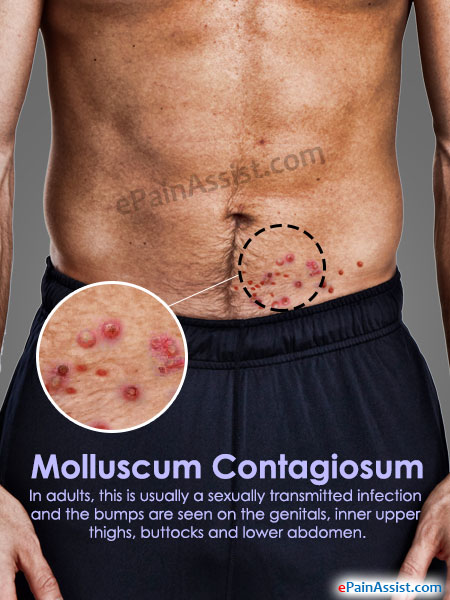Molluscum Contagiosum (MC) is a viral skin infection, which is characterized by firm, round, painless bumps, which can be as small as a pinhead, to as big as a pencil eraser. If the bumps get injured or scratched, then the infection spreads to the adjacent skin. Molluscum contagiosum can affect anyone; however, it is more common in children. Adults with weak immune systems are more prone to have this infection. If the molluscum contagiosum affects the genitals in adults, then it is considered a STI or sexually transmitted infection. Molluscum contagiosum is contagious and spreads via direct skin to skin contact and through touching contaminated objects. The bumps of molluscum contagiosum commonly resolve in a year without treatment; however, it is recommended to get them removed by a doctor or surgeon.

Causes and Risk Factors of Molluscum Contagiosum (MC)
The Cause of Molluscum Contagiosum (MC) is a Virus Which Spreads Easily By:
- Direct skin-to-skin contact with an affected person.
- Touching or using contaminated objects, like towels, toys, faucet and door handles.
- Rubbing or scratching the bumps causes the virus to spread to the adjacent skin.
- Having sexual contact with a person who has Molluscum Contagiosum.
- Children who are suffering from atopic dermatitis are at a higher risk for contracting molluscum contagiosum infection.
- People with weak immune system are at a higher risk for contracting molluscum contagiosum infection.
Signs and Symptoms of Molluscum Contagiosum (MC)
- Appearance of small, round, flesh colored, raised bumps on the skin.
- These bumps are usually around 2 to 5 millimeters in width.
- They have a small dot or indentation at the apex.
- These bumps can be inflamed or become red.
- Scratching or rubbing can remove these bumps and also cause it to spread to the surrounding skin.
- These bumps commonly develop on the face, neck, hands, arms and armpits in children.
- Whereas, in adults, this is usually a sexually transmitted infection and the bumps are seen on the genitals, inner upper thighs, buttocks and lower abdomen.
Investigations for Molluscum Contagiosum (MC)
Physical examination is usually sufficient for diagnosis. For more definitive diagnosis, scrapings from the affected region/bumps can be taken for testing.
Treatment for Molluscum Contagiosum (MC)
Molluscum Contagiosum (MC) commonly resolves or goes away on its own without treatment within a year. However, it is recommended to remove the bumps, especially in adults, as they are contagious. The following treatment options are followed:
Medications for Molluscum Contagiosum (MC)
- Irritating products containing potassium hydroxide or salicylic acid help in dissolving the lesions over the time. Other medicines cause a blister to develop under the bump, which lifts it from the skin.
- Antiviral creams like imiquimod are also prescribed and are quite effective in removing the bumps of Molluscum Contagiosum (MC).
- Surgical procedures, such as scraping and cryotherapy, are also done to remove the molluscum contagiosum lesions.
- Laser therapy is also beneficial in treating Molluscum Contagiosum (MC).
Prevention of Molluscum Contagiosum (MC)
- Keep your hands clean by washing them frequently to prevent the virus from spreading.
- Never touch the bumps and avoid shaving over them.
- Never ever share personal things like towels, clothing, razors, and hairbrushes etc.
- Cover the lesions with a bandage to avoid spreading of this condition.
- Avoid having sexual contact with individuals with Molluscum Contagiosum (MC) lesions near or on the genitals.
